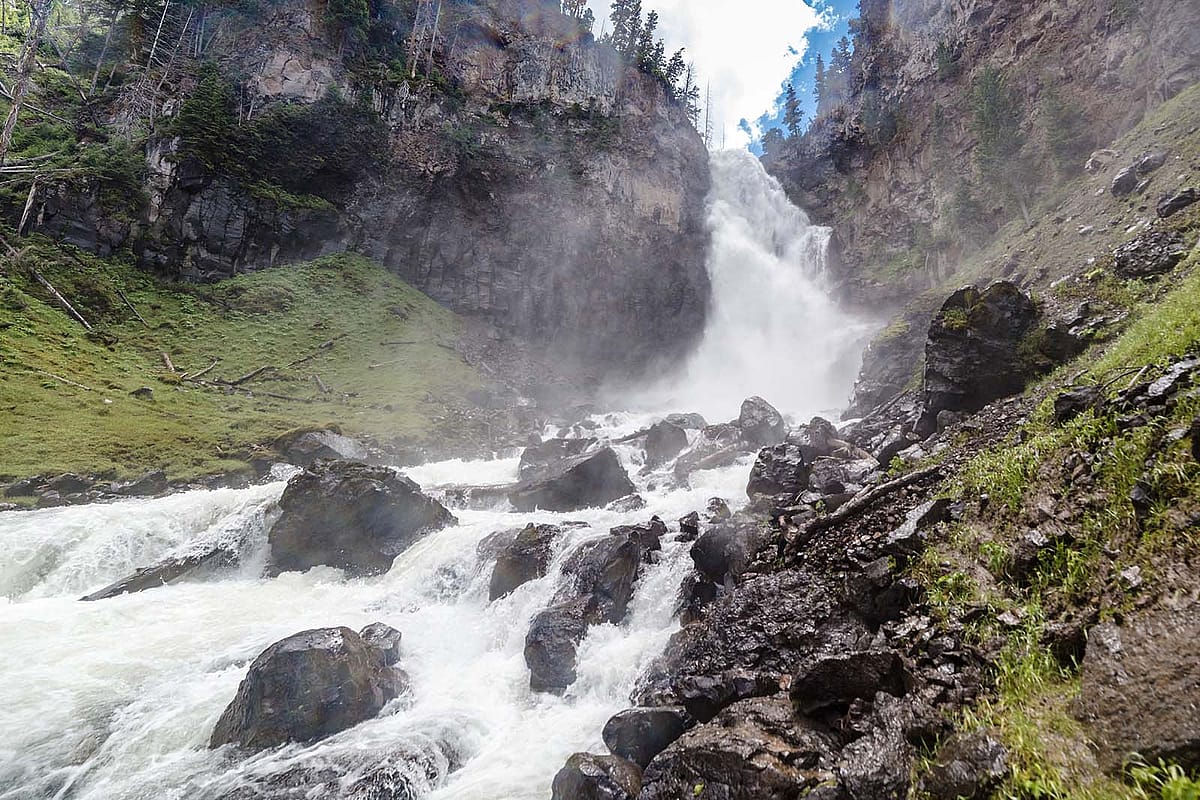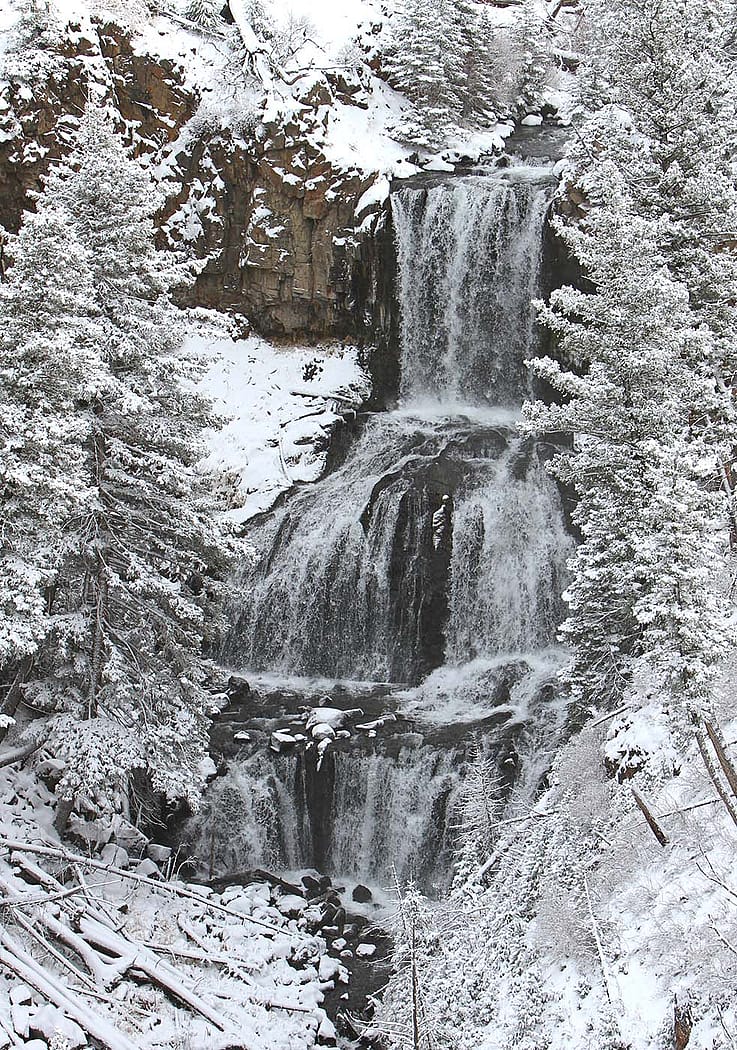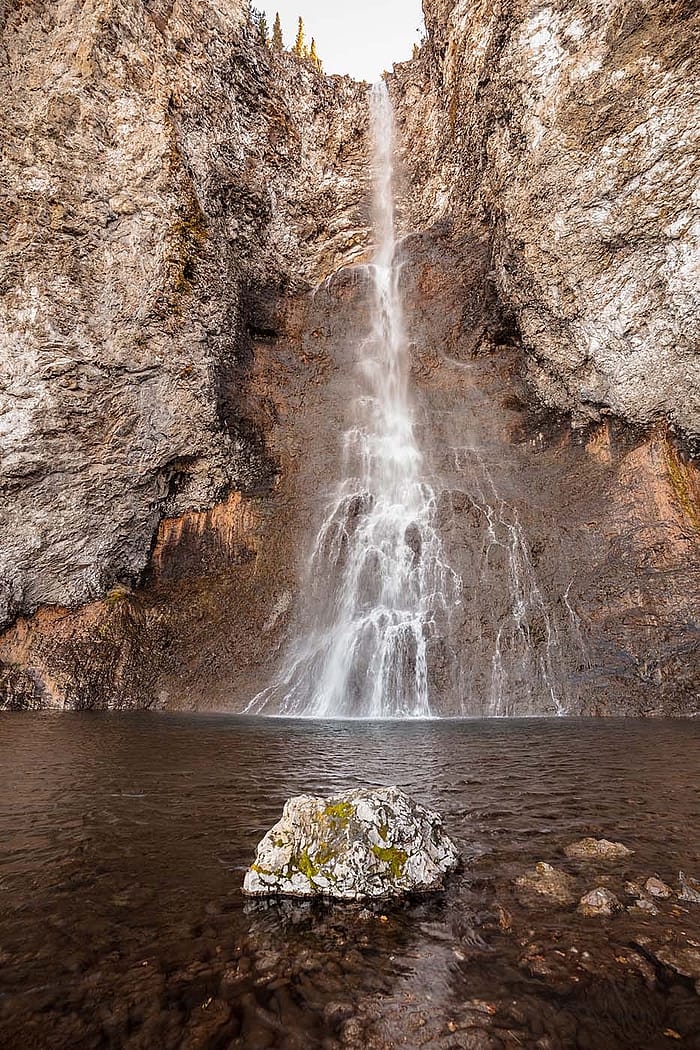
M.C. Poulsen’s Waterfalls of Wonderland – Points West Online
Originally published in Points West magazine
Summer 2022
Waterfalls of Wonderland: Revealing Yellowstone’s Hidden Treasures
By Tessa Baker
Even 150 years after becoming the world’s first national park, Yellowstone still holds a few secrets.
In the mountainous wonderland where mud boils and thousands of wild creatures roam, some features remain hidden—unseen by millions of tourists, unmapped by early explorers, and unknown to even the most seasoned adventurers.
Amid Yellowstone National Park’s splendor and many wonders, “the waterfalls got eclipsed,” said Lee Whittlesey, author and retired park historian.
Three decades ago, Whittlesey partnered with Paul Rubinstein and Mike Stevens to document the park’s waterfalls, many for the first time.
“Over and over, we were amazed at what we found,” Whittlesey said.
Through countless hikes deep into Yellowstone’s forests and years of research, the trio—who expected to find only a handful of previously uncharted waterfalls—found scores of them. They published their findings in the 2000 book The Guide to Yellowstone Waterfalls and Their Discovery. A second book is in the works.

In his research, Rubinstein has dug into archives, pored over old maps, studied aerial surveys, and scrutinized satellite imagery in search of waterfalls.
“I know of the location of no less than 500 waterfalls in Yellowstone… And I would say there are probably 100 more hidden in the forest that can’t be seen from the air,” he said.
While Indigenous Peoples and early explorers witnessed many of the cascading wonders, the park is so vast and rugged that Rubinstein believes some waterfalls remain undiscovered.
“I’m convinced there are still pockets of Yellowstone in some areas, not even that far from roads, that have still never felt the feet of man,” he said.
‘The Wilder Areas”
When artist M.C. Poulsen heard the authors speak during a presentation at the Buffalo Bill Center of the West more than a decade ago, he was mesmerized.
“When I heard the talk, and they showed me the waterfalls in that backcountry, I said, ‘Oh, that’s it,’” Poulsen recalled.
He knew then that he wanted to paint secluded waterfalls for those who would never have the opportunity to go there.

The treks can be dangerous. In compiling their Yellowstone waterfalls guide, two of the authors were struck by lightning. They also encountered grizzly bears, careened down hillsides, and broke through thermal areas with thin crusts.
In the case of Poulsen, he and his son found themselves on the outer edge of a sinkhole during one of their adventures.
As both a gifted artist and skilled outdoorsman with extensive experience in Wyoming’s backcountry, Poulsen is uniquely suited to venture into remote areas of Yellowstone, armed with bear spray and a sketchbook.
“I was already very acquainted with packing in and taking care of the horses and everything else you’ve got to do,” he said.
That includes working with an outfitter, getting permits, and making reservations a year in advance.
Poulsen’s passion and the lengths to which he and his partners went to access and document the waterfalls across the park impressed Karen B. McWhorter, former Scarlett Curator of Western American Art for the Whitney Western Art Museum and current Collier-Read Director of Curatorial, Education, and Museum Services at the Center.
She decided to feature Poulsen’s artwork in the Center of the West’s special exhibition, Yellowstone: For the Benefit and Enjoyment of the People, which marks the park’s 150th anniversary and is on view through January 29, 2023.

Poulsen’s sketches and paintings introduce the Center’s visitors to “a different side of the park—the wilder areas beyond the paved roads,” McWhorter said.
While the first national park exists for the benefit and enjoyment of the people, the vast majority of Yellowstone isn’t regularly visited.
“Most people see only about 1 to 2 percent of the park, and unfortunately, the 1 to 2 percent that they do see is where everybody else is wanting to see—the scenic features,” said Jeremy Johnston, Tate Endowed Chair of Western History.
The Center’s special exhibition goes beyond the popular features, showcasing the park’s significance to various groups—Indigenous Peoples, fur traders, scientists, artists, and tourists.
“Our overall mission for the whole exhibition was basically to highlight the different cultural groups that were connected to Yellowstone and to consider how they benefited and enjoyed the broader Yellowstone Ecosystem,” Johnston said.

The special exhibition features a broad range of objects and content stemming from all five museum collections and the research library, McWhorter said.
She hopes visitors “might walk away with a deeper understanding of the complexity of relationships between diverse individuals and communities to the Greater Yellowstone Ecosystem, past and present.”
For thousands of years, Indigenous Peoples resided in Yellowstone and relied on its resources, from bighorn sheep for food and clothing to sulfur from the springs to tan hides, Johnston said. In his artwork, Poulsen acknowledges the Native precedence and presence by including Native peoples in several of his waterfall paintings, McWhorter noted.
Poulsen has come across Native artifacts in Yellowstone’s backcountry.
“We found partial wickiups (temporary huts made of vegetation) that were still set up in the trees,” he said.
In his hikes, Rubinstein has also found various signs of human history—such as mining equipment from the mid-1800s, before the area became a national park.
“There’s another Yellowstone that isn’t like the Yellowstone you know, and it’s that other 98 percent when you’re off the trail,” Rubinstein said. “There’s just discoveries to be made everywhere.”
Parallels to the Past
By documenting Yellowstone’s unique features, the modern waterfall surveyors have in some ways followed in the footsteps of the 1871 expedition led by Ferdinand Vandeveer Hayden.
The expedition’s initial goal wasn’t to protect the area, but to determine how to best develop and manage it, focusing more on what natural resources could be developed, Johnston said.
“In Yellowstone, there wasn’t anything in there that was seen that could be financially developed,” he said. “There’s a lot of neat natural wonders, scenic areas, but they weren’t finding the geological formations that said, ‘Oh, wow, there’s a bunch of gold and silver here.’”

The Hayden expedition produced something else of value: “a whole slew of maps, geological information, natural history down to the plants, the botany, the wildlife,” Johnston said.
Yellowstone was such a unique place that it became America’s first national park.
Unlike the Hayden expedition, the authors of the waterfalls guide sought to document scenic wonders for their beauty, bringing to light for many people “how special that backcountry is and just how vast and remote it is,” Johnston said.
Poulsen’s own waterfall project has more parallels to the work of Thomas Moran, “perhaps the best-known historical artist to depict the Yellowstone area,” McWhorter said.
Like Moran, Poulsen is awed by the power and beauty of nature, and both artists’ work strikes a reverential tone, she said.
Poulsen called it a privilege to paint Yellowstone’s hidden waterfalls.
“It has become my legacy,” he said.
As the park marks 150 years, Poulsen emphasized how important it is to protect its most precious resource, and the subject of his work: water.
From its pristine streams to deep alpine lakes to boiling hot springs to cascading falls, water brings life to the park—and beyond.
“It flows out in four directions,” Poulsen said. “A lot of people depend on Yellowstone when you think about it.”
Beyond coming away with a renewed appreciation for water, Poulsen also hopes his paintings show “there are things out there that can still be discovered.”
Even when a person isn’t the first to set foot in a certain place, Johnston said there’s something meaningful about “our own rediscoveries.”
“We may not be able to go in the backcountry…and see some of these waterfalls,” Johnston said. “But I think all of us kind of have that sense of discovery whenever we go into a place like Yellowstone.”

About the author
Tessa Baker is a freelance writer with 15 years of experience in journalism. She lives in Powell and enjoys everyday adventures with her husband and two sons.
Post 335
Written By
Nancy McClure
Nancy now does Grants & Foundations Relations for the Center of the West's Development Department, but was formerly the Content Producer for the Center's Public Relations Department, where her work included writing and updating website content, publicizing events, copy editing, working with images, and producing the e-newsletter Western Wire. Her current job is seeking and applying for funding from government grants and private foundations. In her spare time, Nancy enjoys photography, reading, flower gardening, and playing the flute.












